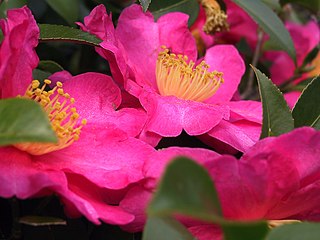
Camellia is a genus of flowering plants in the family Theaceae. They are found in tropical and subtropical areas in eastern and southern Asia, from the Himalayas east to Japan and Indonesia. There are more than 220 described species. Camellias are popular ornamental, tea, and woody-oil plants cultivated worldwide for centuries. Over 26,000 cultivars, with more than 51,000 cultivar names, including synonyms, have been registered or published.

Hydrangea, commonly named the hortensia, is a genus of more than 70 species of flowering plants native to Asia and the Americas. By far the greatest species diversity is in eastern Asia, notably China, Korea, and Japan. Most are shrubs 1–3 m tall, but some are small trees, and others lianas reaching up to 30 m (100 ft) by climbing up trees. They can be either deciduous or evergreen, though the widely cultivated temperate species are all deciduous.
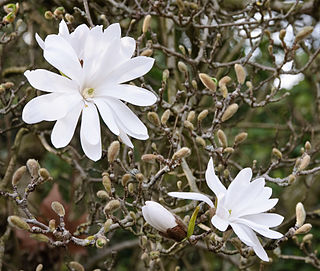
Magnolia stellata, the star magnolia, is a slow-growing deciduous shrub or small tree native to Japan. It bears large, showy white or pink flowers in early spring, before its leaves open. This species is closely related to the Kobushi magnolia, and is treated by many botanists as a variety or even a cultivar of that. However, Magnolia stellata was accepted as a distinct species in the 1998 monograph by Hunt.
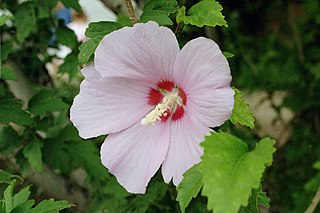
Hibiscus syriacus is a species of flowering plant in the mallow family, Malvaceae. It is native to areas of east Asia, but widely introduced elsewhere, including much of Europe and North America. It was given the epithet syriacus because it had been collected from gardens in Syria. Common names include the rose of Sharon,, Syrian ketmia, shrub althea (or simply althea), and rose mallow. It is the national flower of South Korea and is mentioned in the South Korean national anthem.
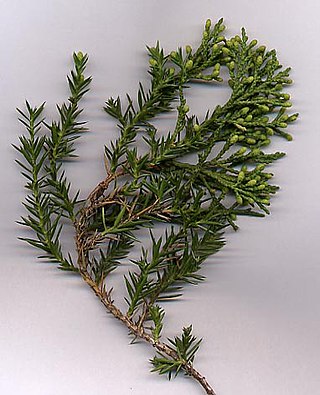
Juniperus chinensis, the Chinese juniper, is a species of plant in the cypress family Cupressaceae, native to China, Myanmar, Japan, Korea and the Russian Far East. Growing 1–20 metres tall, it is a very variable coniferous evergreen tree or shrub.

Berberis, commonly known as barberry, is a large genus of deciduous and evergreen shrubs from 1–5 m (3.3–16.4 ft) tall, found throughout temperate and subtropical regions of the world. Species diversity is greatest in South America and Asia; Europe, Africa and North America have native species as well. The best-known Berberis species is the European barberry, Berberis vulgaris, which is common in Europe, North Africa, the Middle East, and central Asia, and has been widely introduced in North America. Many of the species have spines on the shoots and all along the margins of the leaves.

Syringa vulgaris, the lilac or common lilac, is a species of flowering plant in the olive family Oleaceae, native to the Balkan Peninsula, where it grows on rocky hills. Grown in spring for its scented flowers, this large shrub or small tree is widely cultivated and has been naturalized in parts of Europe, Asia and North America. It is not regarded as an aggressive species. It is found in the wild in widely scattered sites, usually in the vicinity of past or present human habitations.

Hydrangea macrophylla is a species of flowering plant in the family Hydrangeaceae, native to Japan. It is a deciduous shrub growing to 2 m (7 ft) tall by 2.5 m (8 ft) broad with large heads of pink or blue flowers in summer and autumn. Common names include bigleaf hydrangea, French hydrangea, lacecap hydrangea, mophead hydrangea, and hortensia. It is widely cultivated in many parts of the world in many climates. It is not to be confused with H. aspera 'Macrophylla'.

Rosa gallica, the Gallic rose, French rose, or rose of Provins, is a species of flowering plant in the rose family, native to southern and central Europe eastwards to Turkey and the Caucasus. Rosa gallica was one of the first species of rose to be cultivated in central Europe. It is a parent of several important cultivars.

Ilex aquifolium, the holly, common holly, English holly, European holly, or occasionally Christmas holly, is a species of flowering plant in the family Aquifoliaceae, native to western and southern Europe, northwest Africa, and southwest Asia. It is regarded as the type species of the genus Ilex, which by association is also called "holly". It is an evergreen tree or shrub found, for example, in shady areas of forests of oak and in beech hedges. In the British Isles it is one of very few native hardwood evergreen trees. It has a great capacity to adapt to different conditions and is a pioneer species that repopulates the margins of forests or clearcuts.

Streptocarpus is an Afrotropical genus of flowering plants in the family Gesneriaceae. The genus is native to Afromontane biotopes from central, eastern and southern Africa, including Madagascar and the Comoro Islands. The flowers are five-petalled, salverform tubes, almost orchid-like in appearance, and hover or arch over the plant, while the pointed, elongate fruit is of a helical form similar to that of the "tusk" of a narwhal. In the wild, species can be found growing on shaded rocky hillsides or cliffs, on the ground, in rock crevices, and almost anywhere the seed can germinate and grow. For the home, there are now many hybrids of various colours and forms available.
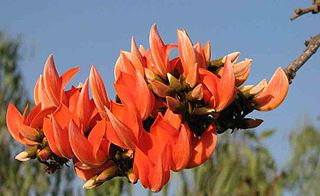
Butea monosperma is a species of Butea native to tropical and sub-tropical parts of South Asia and Southeast Asia. It is also known as flame of the forest, Bengal kino, dhak, palash, and bastard teak. Revered as sacred by Hindus, it is prized for producing an abundance of vivid blooms, and it is also cultivated elsewhere as an ornamental.

Dicentra formosa is a species of flowering plant in the poppy family, Papaveraceae. With its fern-like foliage and inflorescence of drooping pink, purple, yellow or cream "hearts", this species is native to the United States' Pacific Northwest and West Coast of North America.

Sambucus nigra is a species complex of flowering plants in the family Adoxaceae native to most of Europe. Common names include elder, elderberry, black elder, European elder, European elderberry, and European black elderberry. It grows in a variety of conditions including both wet and dry fertile soils, primarily in sunny locations. The plant is widely grown as an ornamental shrub or small tree. Both the flowers and the berries have a long tradition of culinary use, primarily for cordial and wine.

Acer japonicum, fullmoon maple, or downy Japanese-maple, is a species of maple native to Japan, on Honshū, Hokkaidō, Kyūshū, and also southern Korea.

Hibiscus mutabilis, also known as the Confederate rose, Dixie rosemallow, cotton rose or cotton rosemallow, is a plant long cultivated for its showy flowers. Originally native to southern China, it is now found on all continents except Antarctica.

Acer palmatum, commonly known as Japanese maple, palmate maple, or smooth Japanese maple (Korean: danpungnamu, 단풍나무, Japanese: irohamomiji, イロハモミジ, or momiji,, is a species of woody plant native to Korea, Japan, China, eastern Mongolia, and southeast Russia. Many different cultivars of this maple have been selected and they are grown worldwide for their large variety of attractive forms, leaf shapes, and spectacular colors.

Sorbus pseudovilmorinii is a species of variable deciduous flowering tree.

Acer pycnanthum, the Japanese red maple, is a species of maple native to Japan, and introduced to Korea. A tree usually about 20 m, reaching 30 m, it prefers to grow in relict mountain wetlands. It flowers in April, prior to the emergence of leaves. Although considered Vulnerable in its native habitat, it has found some use as a street tree, and is the official tree of a number of Japanese municipalities and of Aichi Prefecture.

Rosa primula, also known as the incense rose, is a species of wild shrub rose that originated in China and Turkestan.




















